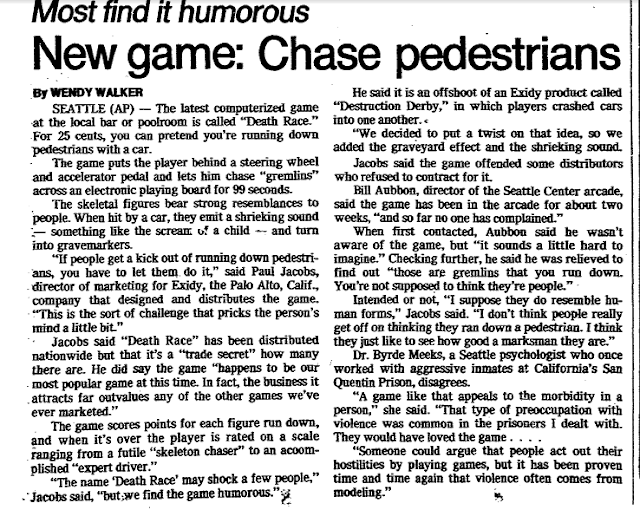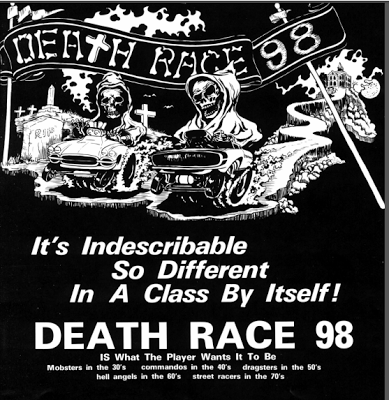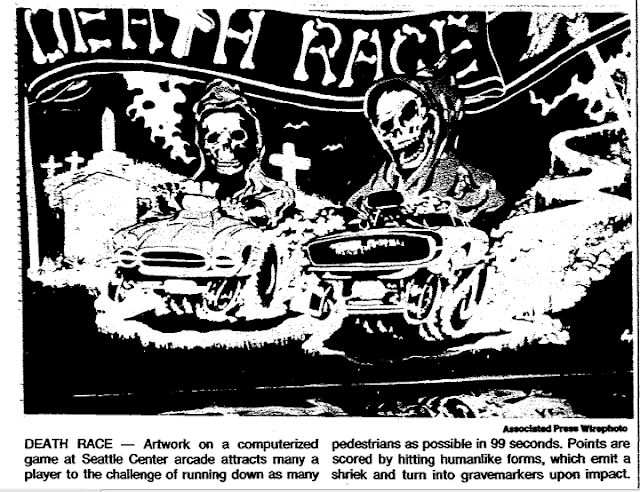Death Race screenshot |
Released in April, 1976, Death Race was not Exidy’s first driving game – that honor goes to 1975’s Destruction Derby, itself a game unlike the host of other driving games on the market. While it had standard driving controls, the gameplay was anything but. Rather than a simple racing game Destruction Derby was a video version of the demolition derby in which a group of cars competed in an arena and tried to bash each other into pieces of useless wreckage. The last car that remained drivable was dubbed the “winner”.
Initially produced by Exidy,
the demand for Destruction Derby
was so great that they licensed it to the floundering Chicago Coin who produced
the game as Demolition Derby. As part of the deal, Exidy halted
production of the game to avoid competing with their new licensee, but in the
end, it didn’t matter. At the time, Chicago Coin was already in the midst of
the financial woes that would lead to bankruptcy in 1976 and when they were
unable to make their royalty payments, Exidy was left holding the bag. While
Exidy may not have seen much in the way of profit from the Demolition/Destruction Derby deal, the experience did result in a
couple of very profitable decisions. First, seeing the sales success of the
Chicago Coin title, Exidy decided that they would no longer license games to
other companies. The second decision proved even more profitable.
While Chicago Coin was marketing Destruction Derby, Exidy found themselves in an awkward position.
Unable to produce their own version of the game and not receiving any money
from licensing it, they decided to come up with a similar concept game instead.
The task was given to newcomer Howell Ivy, his first assignment for the company[1].
It appears that the game was initially called Death Race 98 since flyers and photos with that title appeared in
early 1976. A month or so later flyers began appearing with the Death Race title instead. The game Ivy
came up with would launch the first (though certainly not the last) national
controversy in the fledgling video game industry.
The goal of the game was fairly simple, if somewhat gruesome –
rather than trying to destroy each other’s cars, the players would score points
by running over fleeing stick figures called "gremlins". A score of
1-3 points earned the player the rank of Skeleton Chaser; 4-10 points Bone
Cracker; 11-20 Gremlin Hunter; and for more than 20 points, a player was dubbed
Expert Driver (though real-world pedestrians might not agree with this
assessment).
 |
Howell Ivy, designer of Death Race |
Adding to the game’s morbid theme was its equally gruesome cabinet
art, created by Pat “Sleepy” Peak. Among the images was a grim reaper standing
before two open graves beckoning toward a pair of drivers. The sound effects also
added a chilling touch - when the player hit a gremlin, it emitted a tiny
electronic scream and was replaced by a cross. The gameplay bore a suspicious
resemblance to the 1975 film DeathRace
2000, and most sources report that the game was directly inspired by the
movie, though sources at Exidy (including designer Howell Ivy) insist this
wasn’t the case. Released in 1976, Death
Race[2]
created a firestorm of controversy.
[Paul Jacobs] Death Race
did cause quite a stir, but not until an Associated Press reporter ran a story
in Seattle. She had been in a shopping mall and noticed a line of kids
extending out the door of the arcade in the mall. She was curious and went
to see what was happening and found out they were all waiting in line to play Death Race. She watched them play
and then she concluded that this was a horrible game that showed humans being
run over by cars and said the sound when hit resembled a "shrieking
child". Well, every paper in the country picked up the story and
that started the controversy. The funny thing is that Death Race was just a "filler" game until our next
attraction, Car Polo, was ready for
production. It was a modification of Destruction
Derby using cars versus skeletons rather than cars versus cars. It
required very little development time. We had only released 200
games, but after the notoriety, we ended up making around 3000 (including PCB
sales overseas). Articles about the game were in all major newspapers, plus Newsweek, Playboy, National Enquirer,
National Observer. Midnight, the German magazine Stern, and many more. Nationally syndicated columnist Bob
Greene devoted a column to the game. I was interviewed and featured on the
NBC television news magazine show "Weekend" with Lloyd
Dobbins and then excerpts were shown the following week on the Today show and
the Tonight show. The interview was then featured in a PBS television
documentary called "Decades" as an important news event for the year
1977. I did live interviews for many U.S. radio stations and
also both CBC (Canada) and BBC (England). It was a story that just
wouldn't die, and Exidy laughed all the way to the bank.
 |
Photo of Death Race from the August 1976 Play Meter.That's Paul Jacobs in front. |
In the AP article (written by Wendy Walker), Jacobs is quoted as
saying "If people get a kick out of running down pedestrians, you have to
let them do it". Another quote came courtesy of Dr. Byrde Meeks, a
psychologist who'd worked at San Quentin:
"A game like that appeals to the morbidity in a person. That type
of preoccupation with violence was common in the prisoners I dealt with. They
would have loved the game"[3].
 |
The article that started it all.This one is from the July 3, 1976 Daily Oregonian. |
If Exidy thought things would blow over after the AP story, they
soon found otherwise as more articles began to appear in the following months. In response, Exidy further emphasized the fact
that the game was a harmless diversion and that they'd been careful to avoid
depicting actual pedestrians[4].
"We have one of the
best artists in the business." said GM Phil Brooks "If we wanted to
have cars running over pedestrians we could have done it to curl your
hair." As for the "scream" the game emitted when you ran over a
gremlin - that was just a beep. "We could have had screeching of tires,
moans, and screams for eight bucks extra. But we wouldn't build a game like
that. We're human beings too."[5]
 |
Another AP article on the game.From the 12/24/76 Times Picayune (New Orleans) |
The
hysteria exhibited in some of the articles was almost comical. A Tucson Daily Citizen article was titled
"If You've Got Time to Kill…Game Goal: Road Carnage". A photograph of
a young girl playing the game bore the caption "Death race or death
wish?" and asked if the game was a harmless fad or "…will chasing
down pedestrians on a TV screen now encourage her to cut pedestrians down on
real highways later?" The article quotes one arcade manager, who compares
the game to Gun Fight, a game whose
violence he feels is harmless: "…but that's the tradition of the Great
American West, having a shootout, a duel, in the street. But deliberately
running people down - that isn't an American tradition at all" (guess he's
never driven in Boston) Another operator explained "When you leave a game
room, you don't go out with a gun in your pocket and shoot your neighbor down.
But you do go back to your car and start driving again."[6]
 |
Middltown (NY) Times Herald Register, 10/31/76 |
Complaints about the game’s violent, grisly theme eventually
reached the pages of the National
Enquirer and Midnight and the
game was even featured in more serious forums such as NBC’s Weekend television show where a
psychiatrist decried the game’s supposed promotion of violence. Even the
National Safety Council got in on the act, calling the game “sick” and
“morbid”. A Newsweek article on the game was titled “Sick,
Sick, Sick” (echoing the National Safety Council).
Over the years, a number of rumors about the controversy caused by
Death Race have appeared, among
them: that a bomb threat was called into Exidy headquarters by someone upset
with the game and that the game was banned outright in some countries resulting
in some foreign operators serving jail time.
[Paul Jacobs] I do not know of any country
that banned the game (all markets that we sold to around the world accepted
it), but I do believe that a Japanese distributor was briefly jailed for
selling it. But I'm not so sure it was necessarily for selling the
game itself or that he did not follow proper import procedures (pay appropriate
import duties, etc.)
 |
Super Death Chase - from Play Meter, November, 1977Below - Play Meter's review of Super Death Chase(January, 1978) |
[1] Though some sources
indicate he’d also designed Destruction
Derby.
[2] Some report that the game was called Pedestrian in early stages of development,
but this seems unlikely given that the “gremlins” were never intended to
represent people. Jacobs claims it never went by Pedestrian.
[3] "Death
Race" Is New Game in Poolrooms,
AP, July 1976
[4] While some sources claim
that the idea of calling the enemies "gremlins" was concocted only
after the controversy erupted, this does not appear to be the case (though they
may have done so to avoid future controversy). The AP article itself quotes a
relieved director of the Seattle Center arcade, "those are gremlins that
you run down. You're not supposed to think they're people".
[5] New York Times, December, 1976
[6] Tucson
Daily Citizen, January 14, 1977









Really great article. The media sure does draw a lot of attention to anything negative. Just have to look at the recent mass shootings to see that. But at the end of the day they also glamorize what they cover. Sales of Death Race prove that much.
ReplyDeleteAnd I guess Super Death Race was another example of sequels not selling in coin-op. If an operator already has a game paid off that's making him money, why would he buy the same game over again? Ms. Pacman is of course the main exception to this, but I also heard someone argue that game was partly responsible for starting the crash. Innovation was stagnant in coin-op in 1982. And innovation is what coin-op needs most to survive.
Isn't it amazing how spun up people got over this game, considering how many different violent or 'morally corrupt' games have been produced in nearly 40 years. Custer's Revenge for the Atari VCS was probably the next 'shocking' game to come out after Death Race, in 1982. Ten years later, the media would focus on Mortal Kombat and Night Trap. Doom and its sequels would be in the hot seat, peaking in 1999 with the Columbine High School Massacre. In 2001, it was Rockstar's turn with Grand Theft Auto III. Since then, FPS and war games have become by far the most-popular games.
ReplyDelete